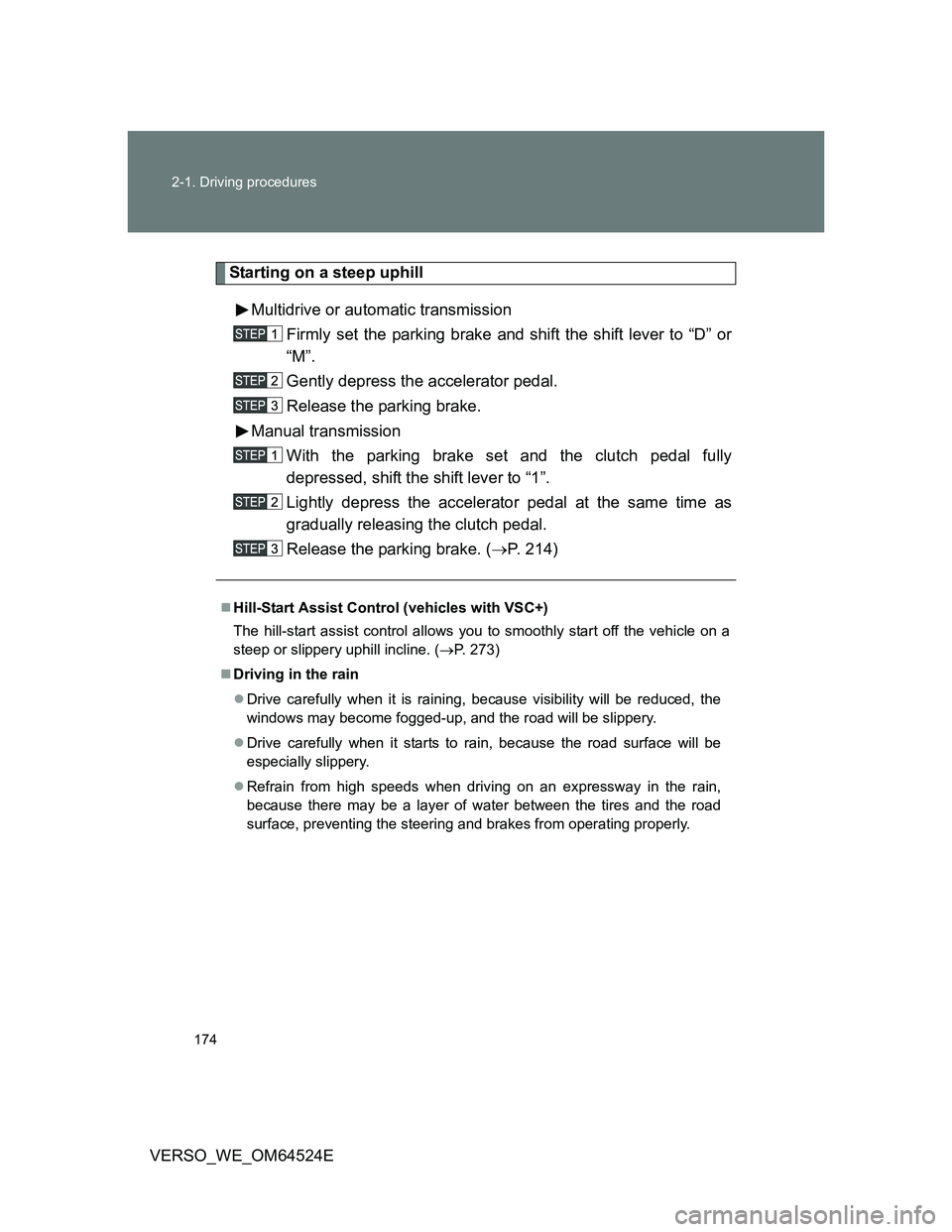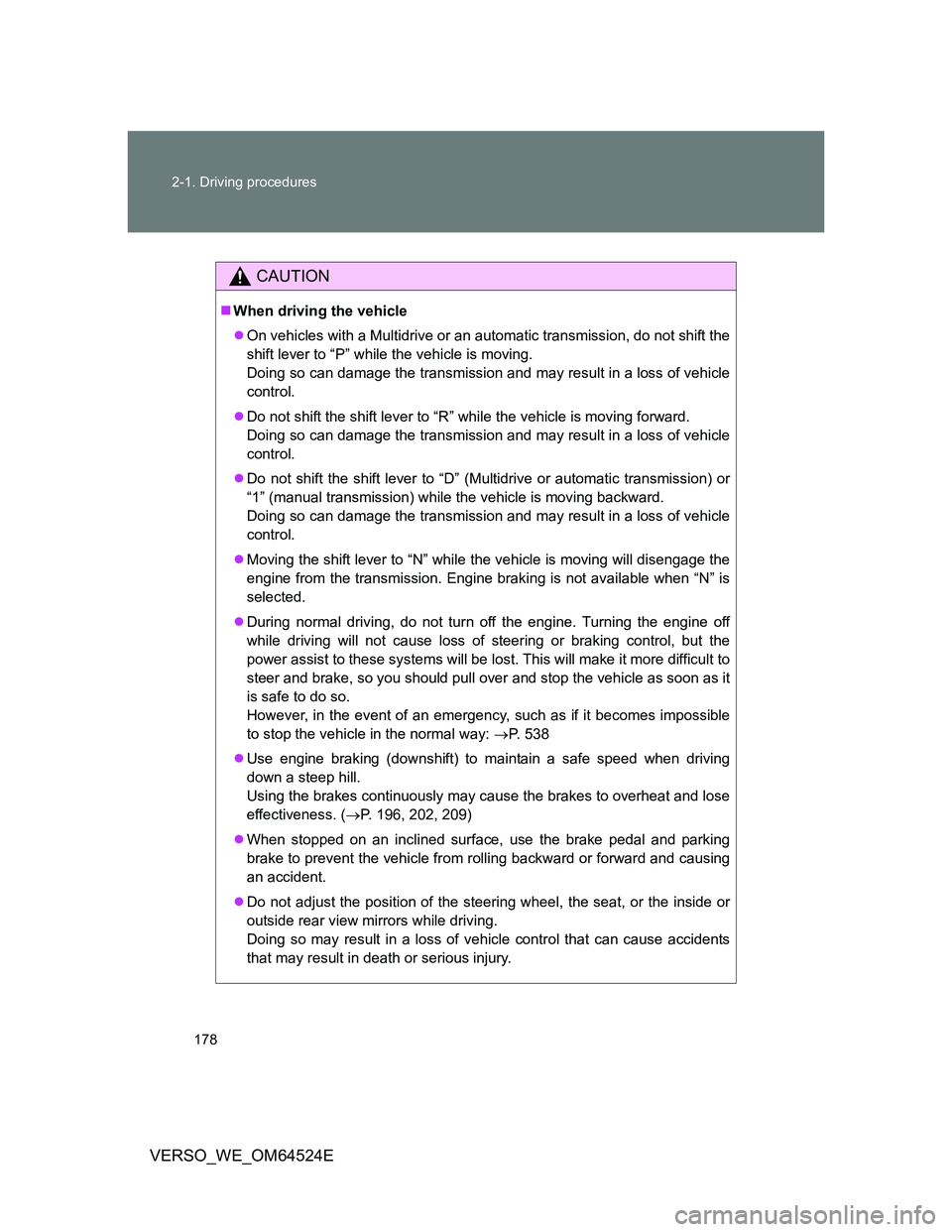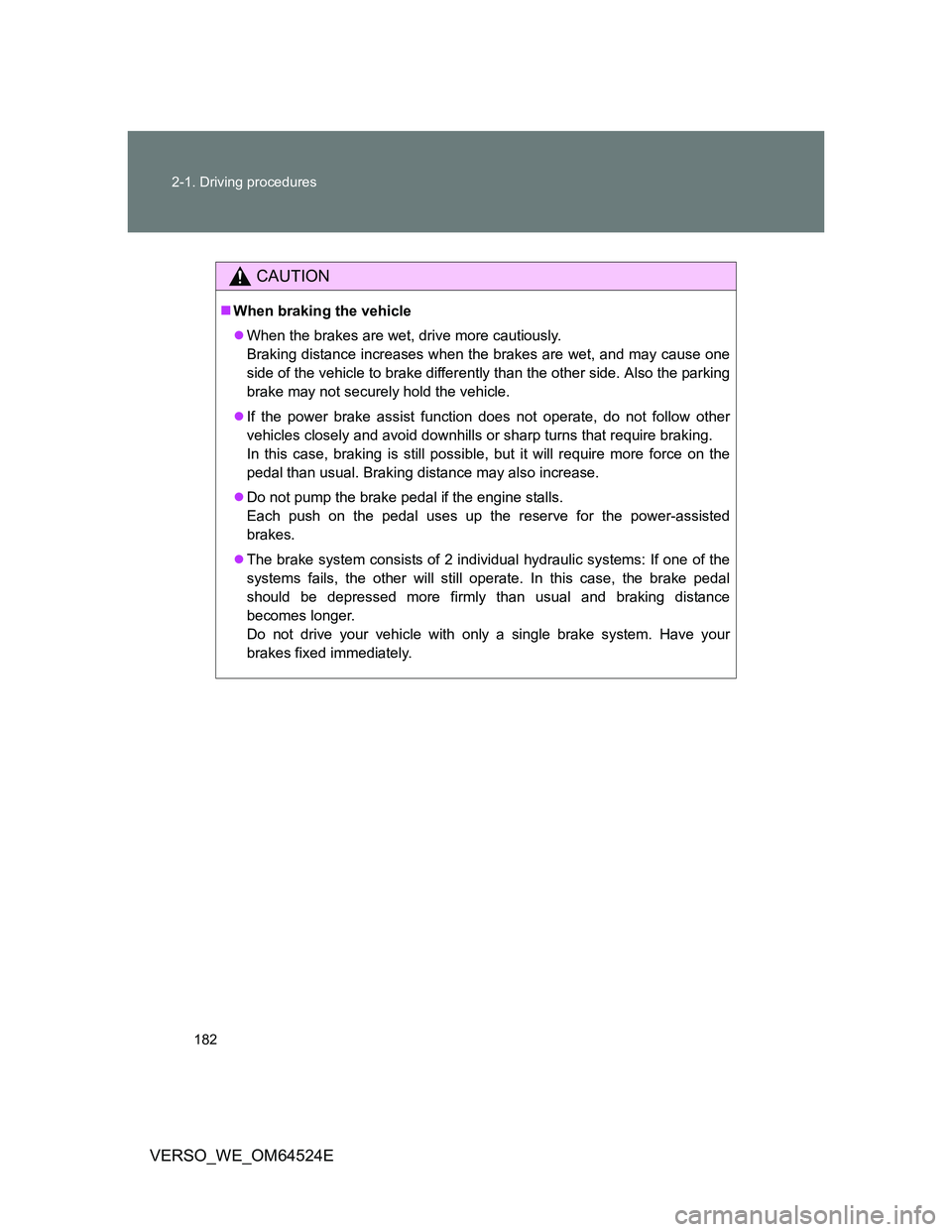Page 174 of 588

174 2-1. Driving procedures
VERSO_WE_OM64524E
Starting on a steep uphill
Multidrive or automatic transmission
Firmly set the parking brake and shift the shift lever to “D” or
“M”.
Gently depress the accelerator pedal.
Release the parking brake.
Manual transmission
With the parking brake set and the clutch pedal fully
depressed, shift the shift lever to “1”.
Lightly depress the accelerator pedal at the same time as
gradually releasing the clutch pedal.
Release the parking brake. (P. 214)
Hill-Start Assist Control (vehicles with VSC+)
The hill-start assist control allows you to smoothly start off the vehicle on a
steep or slippery uphill incline. (P. 273)
Driving in the rain
Drive carefully when it is raining, because visibility will be reduced, the
windows may become fogged-up, and the road will be slippery.
Drive carefully when it starts to rain, because the road surface will be
especially slippery.
Refrain from high speeds when driving on an expressway in the rain,
because there may be a layer of water between the tires and the road
surface, preventing the steering and brakes from operating properly.
Page 178 of 588

178 2-1. Driving procedures
VERSO_WE_OM64524E
CAUTION
When driving the vehicle
On vehicles with a Multidrive or an automatic transmission, do not shift the
shift lever to “P” while the vehicle is moving.
Doing so can damage the transmission and may result in a loss of vehicle
control.
Do not shift the shift lever to “R” while the vehicle is moving forward.
Doing so can damage the transmission and may result in a loss of vehicle
control.
Do not shift the shift lever to “D” (Multidrive or automatic transmission) or
“1” (manual transmission) while the vehicle is moving backward.
Doing so can damage the transmission and may result in a loss of vehicle
control.
Moving the shift lever to “N” while the vehicle is moving will disengage the
engine from the transmission. Engine braking is not available when “N” is
selected.
During normal driving, do not turn off the engine. Turning the engine off
while driving will not cause loss of steering or braking control, but the
power assist to these systems will be lost. This will make it more difficult to
steer and brake, so you should pull over and stop the vehicle as soon as it
is safe to do so.
However, in the event of an emergency, such as if it becomes impossible
to stop the vehicle in the normal way: P. 538
Use engine braking (downshift) to maintain a safe speed when driving
down a steep hill.
Using the brakes continuously may cause the brakes to overheat and lose
effectiveness. (P. 196, 202, 209)
When stopped on an inclined surface, use the brake pedal and parking
brake to prevent the vehicle from rolling backward or forward and causing
an accident.
Do not adjust the position of the steering wheel, the seat, or the inside or
outside rear view mirrors while driving.
Doing so may result in a loss of vehicle control that can cause accidents
that may result in death or serious injury.
Page 182 of 588

182 2-1. Driving procedures
VERSO_WE_OM64524E
CAUTION
When braking the vehicle
When the brakes are wet, drive more cautiously.
Braking distance increases when the brakes are wet, and may cause one
side of the vehicle to brake differently than the other side. Also the parking
brake may not securely hold the vehicle.
If the power brake assist function does not operate, do not follow other
vehicles closely and avoid downhills or sharp turns that require braking.
In this case, braking is still possible, but it will require more force on the
pedal than usual. Braking distance may also increase.
Do not pump the brake pedal if the engine stalls.
Each push on the pedal uses up the reserve for the power-assisted
brakes.
The brake system consists of 2 individual hydraulic systems: If one of the
systems fails, the other will still operate. In this case, the brake pedal
should be depressed more firmly than usual and braking distance
becomes longer.
Do not drive your vehicle with only a single brake system. Have your
brakes fixed immediately.
Page 224 of 588
224 2-2. Instrument cluster
VERSO_WE_OM64524E
Indicators
The indicators inform the driver of the operating state of the
vehicle’s various systems.
Turn signal indicator
(P. 213)
(if equipped)
Speed limiter indicator
(P. 256)
Headlight high beam
indicator (P. 240)
(if equipped)
Eco Driving Indicator
Light (P. 176, 237)
Tail light indicator
(P. 239)
(Blue)
Engine coolant tem-
perature indicator
(if equipped)
Front fog light indicator
(P. 244)Shift position indicator
(P. 196, 202)
Rear fog light indicator
(P. 244)Gear Shift Indicator
(P. 210)
(if equipped)
Slip indicator (P. 268)“SPORT” indicator
(P. 197, 203)
(diesel engine)
Engine preheating
indicator (P. 186, 190)“PASSENGER AIRBAG”
indicator (P. 167)
(if equipped)
Cruise control indicator
(P. 252)Security indicator
(P. 112, 122)
(if equipped)
“SET” indicator
(P. 252)
(if equipped)
Toyota parking assist
indicator (P. 259)
*1,*2
*4
*2
*1,*3
*1*2
Page 259 of 588
259
2-4. Using other driving systems
2
When driving
VERSO_WE_OM64524E
Toyota parking assist-sensor
: If equipped
The distance from your vehicle to nearby obstacles when parallel
parking or maneuvering into a garage is measured by the sensors
and communicated via an indicator and a buzzer. Always check the
surrounding area when using this system.
Types of sensors
Front corner sensors
Front center sensors
Rear corner sensors
Rear center sensors
Toyota parking assist-sensor switch
Left-hand drive vehicles
Turns the Toyota parking
assist-sensor on/off
When on, the indicator light
comes on and the buzzer
sounds to inform the driver
that the system is operational.
Page 260 of 588
260 2-4. Using other driving systems
VERSO_WE_OM64524E
Display
When the sensors detect an obstacle, the Toyota parking assist-sen-
sor indicator is illuminated by an LED depending on position and dis-
tance to the obstacle.
Vehicles with manual air conditioning system
Front center sensor operation
Front corner sensor operation
Vehicle indicator
Rear corner sensor operation
Rear center sensor operation
Right-hand drive vehicles
Page 265 of 588

265 2-4. Using other driving systems
2
When driving
VERSO_WE_OM64524E
Sensor detection information
Certain vehicle conditions and the surrounding environment may affect
the ability of a sensor to correctly detect an obstacle. Particular instances
where this may occur are listed below.
• There is dirt, snow or ice on a sensor.
• A sensor is frozen.
• A sensor is covered in any way.
• The vehicle is leaning considerably to one side.
• On an extremely bumpy road, on an incline, on gravel, or on grass.
• The vicinity of the vehicle is noisy due to vehicle horns, motorcycle
engines, air brakes of large vehicles, or other loud noises producing
ultrasonic waves.
• There is another vehicle equipped with parking assist sensors in the
vicinity.
• A sensor is coated with a sheet of spray or heavy rain.
• The vehicle is equipped with a fender pole or radio antenna.
• Towing eyelet is installed.
• A bumper or sensor receives a strong impact.
• The vehicle is approaching a tall or right-angled curb.
• In harsh sunlight or intense cold weather.
• A non-genuine Toyota suspension (lowered suspension etc.) is
installed.
In addition to the examples above, there are instances in which, because of
their shape, signs and other objects may be judged by a sensor to be closer
than they are.
The shape of the obstacle may prevent a sensor from detecting it. Pay
particular attention to the following obstacles:
• Wires, fences, ropes, etc.
• Cotton, snow and other materials that absorb sound waves
• Sharply-angles objects
• Low obstacles
• Tall obstacles with upper sections projecting outwards in the direction
of your vehicle
Page 266 of 588

266 2-4. Using other driving systems
VERSO_WE_OM64524E
If the vehicle indicator remains on while the corner and center indica-
tors flash and the malfunction beep sounds for approximately 8 sec-
onds.
Have the vehicle inspected by any authorized Toyota dealer or repairer, or
another duly qualified and equipped professional.
If the vehicle indicator and the corner and center indicators flash and
the malfunction beep sounds for approximately 8 seconds.
Clean the sensors with soft cloth.
Customization that can be configured at any authorized Toyota dealer
or repairer, or another duly qualified and equipped professional
Setting of buzzer volume can be changed.
(Customizable featuresP. 569)
CAUTION
Caution when using the Toyota parking assist-sensor
Observe the following precautions.
Failing to do so may result in the vehicle being unable to be driven safely
and possibly cause an accident.
Do not use the sensor at speeds in excess of 10 km/h (6 mph).
Do not attach any accessories within the sensor range.
NOTICE
Notes when washing the vehicle
Do not apply intensive bursts of water or steam to the sensor area.
Doing so may result in the sensor malfunctioning.